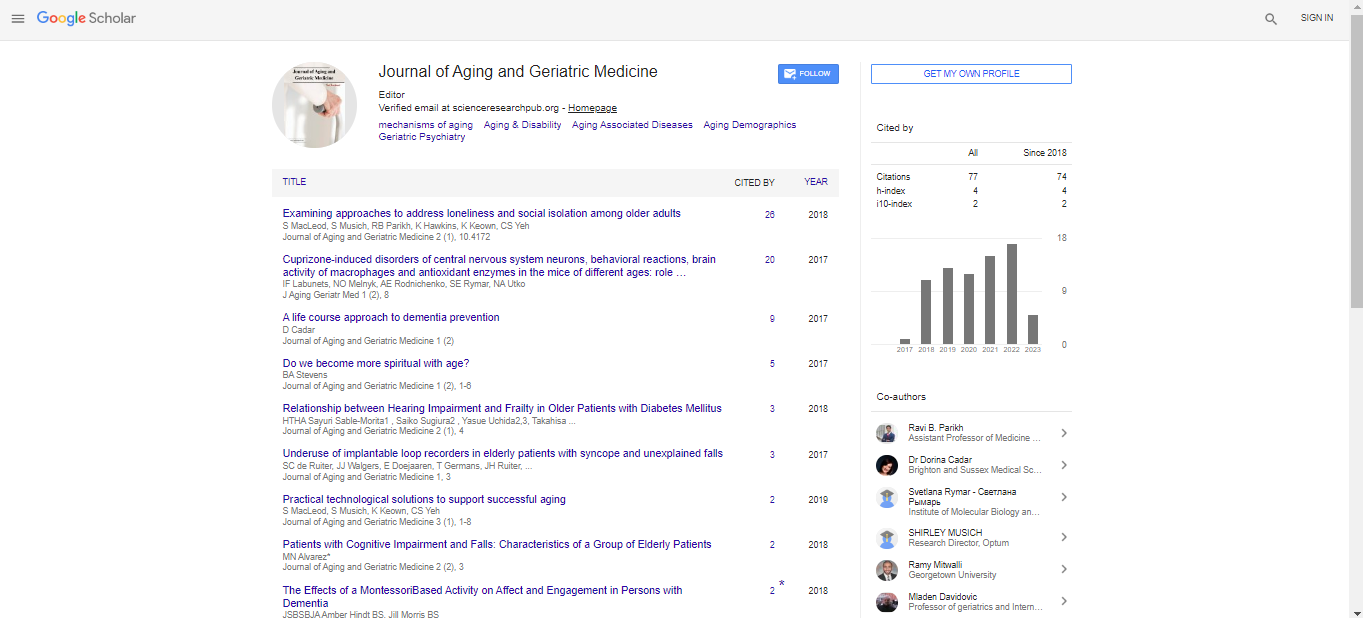Commentary, J Aging Geriatr Med Vol: 8 Issue: 1
An Overview on Endocrine Disease: Diabetes Mellitus
Xiana Chaeni*
Department of Maternal, Child, and Adolescent Health, Anhui Medical University, Hefei, China
- *Corresponding Author:
- Xiana Chaeni
Department of Maternal,
Child and Adolescent Health,
Anhui Medical University,
Hefei,
China
E-mail: xiana_chaeni@gmail.com
Received date: 04 November, 2023, Manuscript No. AGM-23-119216;
Editor assigned date: 07 November, 2023, PreQC No. AGM-23-119216 (PQ);
Reviewed date: 21 November, 2023, QC No. AGM-23-119216;
Revised date: 15 August, 2024, Manuscript No. AGM-23-119216 (R);
Published date: 22 August, 2024, DOI: 10.4172/2576-3946.1000183
Citation: Chaeni X (2024) An Overview on Endocrine Disease: Diabetes Mellitus. J Aging Geriatr Med 8:1.
Description
The prevalence of Diabetes Mellitus (DM) is rising globally as a result of longer life expectancies and changes in lifestyle. When people get older (60–65 years old), Diabetes Mellitus (DM) is becoming a serious public health issue in industrialized and even emerging nations one in two elderly people have diabetes or prediabetes, and eight out of ten elderly people have some dysglycemia. In comparison to their younger counterparts, older diabetics have higher rates of co-morbidities and consequences from their disease. The most common are cardiovascular disorders brought on by aging and premature atherosclerosis unique to Diabetes Mellitus (DM), and the most trying are cognitive and visual deficits, particularly dementias like Alzheimer's. Diabetes Mellitus (DM) and Alzheimer disease appear to have similar risk factors, including insulin resistance brought on by inactivity and eating problems. Treatment for depression, memory problems, and physical and visual impairments are obstacles to receiving DM care. Because of this, elderly diabetics are now divided into two main groups: Those who are independent and fit and can take any medication, just like their peers in their younger or middle age, and those who are fragile or frail and for whom medical care, physical activity, and a healthy diet should be tailored based on the presence or absence of co-morbidities and cognitive impairment. The basic guideline for the final category is to "go slowly and individualize" in order to prevent interactions with elderly people who are overmedicated and prevent deadly iatrogenic hypoglycaemias in those treated with sulfonylureas or insulin seems to be caused by a number of processes, some of which include genetic background, a long life expectancy that reduces insulin secretion, and changes to certain environmental conditions that cause central obesity.
The final one is in charge of insulin resistance, which is the primary cause of type 2 diabetes mellitus and metabolic syndrome in adults and the elderly. One of the most implicated reasons is the current lifestyle's tendency toward eating disorders combined with a lack of physical exercise. Nevertheless, some recent research has also shown the involvement of other variables, such as Arginine Vasopressin (AVP) or its c-terminal fragment, known as competing, in the process of diabetes mellitus in the elderly through decreased insulin sensitivity. AVP also has an impact on glucagon secretion and hepatic glycogenolysis.
Vitamin D insufficiency appears to be an additional component in older adults there is a connection between low vitamin D levels and osteoporosis, insulin resistance, obesity, diabetes mellitus, and cognitive impairment, particularly Alzheimer's disease. For some, on the other hand, a vitamin D deficiency may result from obesity and long-term conditions such GMDs. However, there is experimental evidence that vitamin D prevents fat storage, protects pancreatic islet cells, boosts insulin production, lowers insulin resistance, and decreases appetite. If the effects are genuine, vitamin D replacement therapy ought to stop and manage GMDs.
Conclusion
The average chronological age is a risk factor for a number of chronic illnesses. As people age, their levels of systemic chronic inflammation, oxidative stress, DNA damage, mitochondrial function decrease, cellular senescence, and tissue malfunction all increase. These factors all lead to the development of metabolic diseases, including elevated serum amyloid. An increase in fat mass, particularly visceral adiposity, and a corresponding loss in lean and skeletal mass are the results of age-related variations in body composition. Senescent cells proliferate in adipose tissue while preadipocyte replication declines with age, which increases lipotoxicity and promotes the development of a pro-inflammatory state. Furthermore, research has indicated that aging reduces insulin sensitivity, hinders β-cell insulin production in response to endogenous incretions, and causes mitochondrial malfunction, which ultimately leads to β-cell mortality. Abnormalities in insulin sensitivity and secretion in elderly persons eventually result in reduced glucose tolerance and diabetes with outward manifestations. One of the main characteristics of type 2 diabetes in the elderly is postprandial hyperglycemia. In order to identify diabetes early on, which may otherwise go undetected if fasting plasma glucose levels alone are used, older individuals with impaired fasting glucose should have an oral glucose tolerance test.
 Spanish
Spanish  Chinese
Chinese  Russian
Russian  German
German  French
French  Japanese
Japanese  Portuguese
Portuguese  Hindi
Hindi 